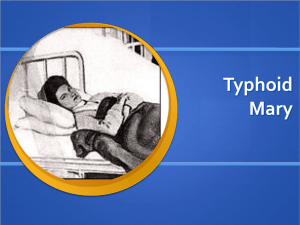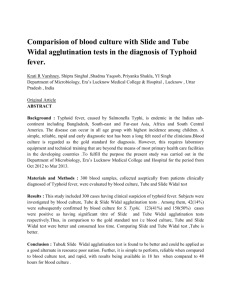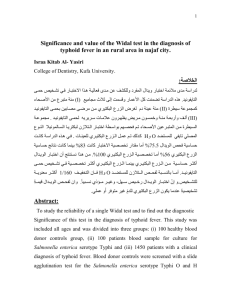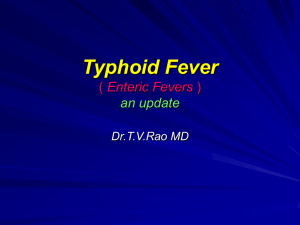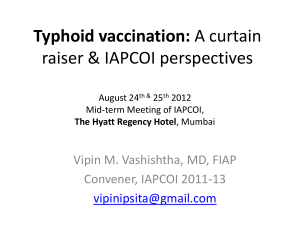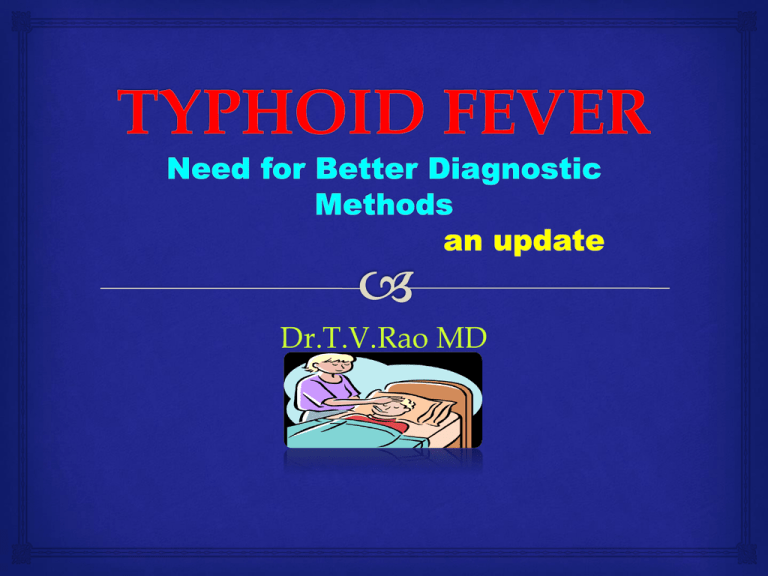
Dr.T.V.Rao MD
What is Typhoid Fever
Typhoid fever, also known as typhoid, is a common
worldwide illness, transmitted by the ingestion of food or
water contaminated with the feces of an infected person,
which contain the bacterium Salmonella enterica enterica
serovar Typhi. The bacteria then perforate through the
intestinal wall and are phagocytized by macrophages. The
organism is a Gram-negative short bacillus that is motile
due to its peritrichous flagella.
The term "enteric fever" is a collective
term that refers to typhoid and
paratyphoid
Endemicity of Typhoid
Fever
Enteric Fevers
The syndrome
associated with enteric
fevers are produced
only by a few of the
Salmonella
Salmonella typhi most
important
Salmonella paratyphi
A, B,C
Bacteriology –Typhoid fever
The Genus
Salmonella belong to
Enterobacteriaceae
Facultative anaerobe
Gram negative bacilli
Distinguished from
other bacteria by
Biochemical and
antigen structure
Epidemiology of Typhoid
Fever
This is a highly adapted, human-specific pathogen
occurring more frequently in underdeveloped regions of
the world where overcrowding and poor sanitation are
prevalent.
According to the best global estimates, there are at least
16 million new cases of typhoid fever each year, with 6,
00,000 deaths (Ivanoff, 1995). Between 1 - 5% of patients
with acute typhoid infection have been reported to
become chronic carriers of the infection, depending on
age, sex and treatment regimen. Furthermore this chronic
carrier state has also been implicated in causation of
carcinoma of the gall bladder.
Antigenic structure of
Salmonella
Two sets of antigens
Detection by serotyping
1 Somatic or 0 Antigens contain long chain
polysaccharides ( LPS ) comprises of heat stable
polysaccharide commonly.
2 Flagellar or H Antigens are strongly
immunogenic and induces antibody formation
rapidly and in high titers following infection or
immunization. The flagellar antigen is of a dual
nature, occurring in one of the two phases.
Diagnosis of Typhoid Fever
( CDC )
Infection with typhoid
or paratyphoid fever
results in a very lowgrade septicemia. Blood
culture is usually
positive in only half the
cases. Stool culture is
not usually positive
during the acute phase
of the disease. Bonemarrow culture increases
the diagnostic yield to about
80% of cases.
WIDAL Test
land Mark In Diagnosis
he Widal test is an old
serologic assay for
detecting IgM and IgG
antibodies to the O and H
antigens of Salmonella.
The test is unreliable, but
is widely used in
developing countries
because of its low cost.
Newer serologic assays
are somewhat more
sensitive and specific than
the Widal test, but are
infrequently available.
Diagnosis
Physician Still Plays the Key Role
Because there is no
definitive test for typhoid
or paratyphoid fever, the
diagnosis often has to be
made clinically. The
combination of a history
of being at risk for
infection and a gradual
onset of fever that
increases in severity over
several days should raise
suspicion of typhoid or
paratyphoid fever.
How we Diagnose Typhoid
Fever
Diagnosis is made by any blood, bone
marrow or stool cultures and with the Widal
test (demonstration of salmonella antibodies
against antigens O-somatic and H-flagellar ).
In epidemics and less wealthy countries, after
excluding malaria, dysentery or pneumonia,
a therapeutic trial time with chloramphenicol
is generally undertaken while awaiting the
results of Widal test and cultures of the blood
and stool.
Blood Cultures in
Typhoid Fevers
Bacteremia occurs
early in the disease
Blood Cultures are
positive in
1st week in 90%
2nd week in 75%
3rd week in 60%
4th week and later in
25%
Identification of
Salmonella
Sub cultures are
done after overnight
incubation at
370c,and subcultures
are done on Mac
Coney's agar
Subcultures are
repeated upto 10
days after further
incubation.
Salmonella on Mac Conkey's
agar
Salmonella on XLD agar
Identifying Enteric
Organisms
Isolates which are Non lactose fermenting
Motile, Indole positive
Urease negative
Ferment Glucose,Mannitol,Maltose
Donot ferment Lactose, Sucrose
Typhoid bacilli are anaerogenic
Some of the Paratyphoid form acid and gas
Further identification done by slide
agglutination tests
Slide agglutination tests
In slide agglutination
tests a known serum
and unknown culture
isolate is mixed,
clumping occurs
within few minutes
Commercial sera are
available for
detection of A,
B,C1,C2,D, and E.
Clot culture
Clot cultures are more
productive in yielding
better results in
isolation.
A blood after clotting,
the clot is lysed with
Streptokinase ,but
expensive to perform in
developing countries.
Bactek and Radiometric based
methods are in recent use
Bactek methods in
isolation of
Salmonella is a rapid
and sensitive method
in early diagnosis of
Enteric fever.
Many Microbiology
Diagnostic
Laboratories are
upgrading to Bactek
methods
Widal Test
In 1896 Widal A professor
of pathology and internal
medicine at the University
of Paris (1911–29), he
developed a procedure for
diagnosing typhoid fever
based on the fact that
antibodies in the blood of
an infected individual
cause the bacteria to bind
together into clumps (the
Widal reaction).
Diagnosis of Enteric Fever
Widal test
Serum agglutinins raise abruptly during the
2nd or 3rd week
The widal test detects antibodies against O
and H antigens
Two serum specimens obtained at intervals
of 7 – 10 days to read the raise of antibodies.
Serial dilutions on unknown sera are tested against
the antigens for respective Salmonella
False positives and False negative limits the utility of
the test
The interpretative criteria when single serum
specimens are tested vary
Cross reactions limits the specificity
Significant Titers helps
in Diagnosis
Following Titers of
antibodies against the
antigens are significant
when single sample is
tested
O > 1 in 160
H > 1 in 320
Testing a paired
sample for raise of
antibodies carries a
greater significance
Widal test
Still a popular test ?
The Widal test (Widal’s agglutination reaction) is
routinely practised for the serodiagnosis of typhoid
fever by most of the laboratories. Several workers have
expressed doubt regarding the reliability of the
test.
Several factors have contributed to this
uncertainty. These include poorly standardised
antigens, the sharing of antigenic determinants with
other Salmonellae and the effects of immunisation with
TAB vaccine. Another major problem relates to the
difficulty of interpreting Widal test results in areas
where Salmonella typhi is endemic and where the
antibody titres of the normal population are often not
known.
Limitations of Widal test
Classically, a four-fold rise of antibody in
paired sera Widal test is considered diagnostic
of typhoid fever. However, paired sera are often
difficult to obtain and specific chemotherapy
has to be instituted on the basis of a single
Widal test. Furthermore, in areas where fever
due to infectious causes is a common occurrence
the possibility exists that false positive
reactions may occur as a result of non-typhoid
Limitation of Widal Test
The Widal test is time
consuming and often
times when diagnosis
is reached it is too late
to start an antibiotic
regimen.
In spite of several
limitation many
Physicians depend on
Widal Test
False Positive and Negative
Reactions with WIDAL Test
The Widal test should be interpreted in the light of
baseline titers in a healthy local population. This is
especially important when there is a high local prevalence
of non-typhoid salmonellosis.4 The Widal test may be
falsely positive in patients who have had previous
vaccination or infection with S typhi.7 Raised
Widal titers have also been reported in association with
the dysgammaglobulinaemia of chronic active hepatitis
and other autoimmune diseases.64 '8 '9 False negative
results may be associated with early treatment, with
"hidden organisms" in bone and joints, and with relapses
of typhoid fever. Occasionally the infecting strains are
poorly immunogenic.
WIDAL Test needs Quality
Control
Often Neglected
?
Quality control of Widal tests is important: a
laboratory which consistently produces poor
results in an external quality control
programme should discontinue the test until
technical problems are solved. 'False positive
results may be due to faulty technique or to
poor quality of the antigen suspension. There
is conflicting evidence as to the relative
importance of somatic and flagellar agglutinin
titers for the diagnosis of typhoid fever
Advances in the Rapid
Diagnosis of Typhoid fever
Typhidot
Typhidot® a test kit that
makes use of 50 kD antigen to
detect specific IgM and IgG
antibodies to S. typhi (Ismail
et al., 1991). It has undergone
full - scale multinational
clinical evaluation of its
diagnostic value (Lu-Fong et
al., 1999; Jackson et al., 1995;
Choo et al., 1997). This dot
EIA test offers simplicity,
speed, specificity (75%),
economy, early diagnosis,
sensitivity (95%) and high
negative and positive
predictive values
Typhidot is better than
Widal Test
Another variant of
Typhidot® is Typhidot-M®
and has shown that
inactivation of IgG removes
competitive binding and
allows access of the antigen
to the specific IgM when it is
present. Evaluation of
Typhidot® and TyphidotM®in clinical settings
showed that they performed
better than the Widal test
and the culture method
(Bhutta and Mansurali,
1999).
Typhidot – Easier to Perform
The Typhidot offers an
additional advantage
among second- line
serologic diagnostic
tests for typhoid fever
in that the test strips do
not require an ELISA
reader for evaluation.
Also, only minimal
operator training is
required
ELISA Method
in Diagnosis of Typhoid Fever
A new technique of rapid screening for Salmonella by
dipstick enzyme-linked immuno sorbent assay
(ELISA) has been shown to be sensitive, specific,
rapid and reproducible for detection of Salmonella
directly from stool. Stool samples are mixed with
buffer Salmonella interaction solution. A dipstick is
placed into the mixture and incubated at room
temperature.
Results of the tests are available in 20 minutes. Early published
results from different studies show a Sensitivity rate of 99% and
specificity of 98%. The dipstick kit is very useful and acceptable
to both patients and health-care providers because of the
following reasons
New Kits being tested
in field
Laboratory confirmation of S. Typhi or S.
Paratyphi as the etiologic agent will be
essential to distinguish typhoid/paratyphoid
from numerous other causes of acute febrile
illness. A rapid diagnostic test (Tubex TF,
IDL Biotech, Bromma, Sweden) can detect
typhoid (but not paratyphoid) antibody in
patient serum. In field trials, the Tubex TF
kit had a sensitivity of 60–78% and a
specificity of 58–89%
®
TUBEX
TF
TF is a 10 minutes semi-quantitative in vitro
TUBEX®
diagnostic assay for detection of acute typhoid fever.
It specifically detects the presence of IgM antibodies
to the S. typhi O9 lipopolysaccharide antigen. This
antigen is highly specific to S. typhi and other
Salmonella serogroup D bacteria by its extremely
rare sugar (a-D-tyvelose). IgM anti-O9 antibodies are
normally not present in healthy individuals, and
thus TUBEX® TF is highly specific. A positive
TUBEX® TF result, together with typical clinical
symptoms of typhoid fever, is highly suggestive of a
typhoid infection.
Principles of TUBEX TF
TUBEX® TF is an inhibition binding assay. In short it
detects the presence of anti-O9 IgM antibodies in
patient serum by assessing the ability to inhibit a
reaction between two colored and antigen/antibodycoated reagents. TUBEX® TF is a semi-quantitative
assay, and thus the level of inhibition is proportional
to the concentration of anti-O9 antibodies in the
sample. The separation is performed in one step by
magnetic force; where after the result is read visually
and scored against a provided color scale.
RT- PCR in Typhoid
PCR amplification for the
detection of pathogens in
biological material is
generally considered a
rapid and informative
diagnostic technique..
Several experimental
methods for PCR
methods in progress.
Needs greater validation
Search for Better Methods for
Diagnosis of Typhoid Fever
Currently, alternative methods for biological
molecular analysis are enzyme immunoassay
, surface plasmo resonance , an
electrochemical immunoassay . In particular,
the use of electrochemical immunoassay has
attracted considerable interest for S.typhi
determination because of its inherent
simplicity, high sensitivity, inexpensive
instrumentation, and miniaturization
Several Emerging Methods
in Diagnosis
Currently, alternative methods for biological
molecular analysis are enzyme immunoassay
, surface plasmo resonance , an
electrochemical immunoassay . In particular,
the use of electrochemical immunoassay has
attracted considerable interest for S.typhi
determination because of its inherent
simplicity, high sensitivity, inexpensive
instrumentation, and miniaturization
Molecular Immunology in
Diagnosis of Typhoid Fever
Recent advances in
molecular immunology
have led to the
identification of
potentially more sensitive
and specific markers in
the blood and urine of
patients with typhoid
fever and enabled the
manufacture of practical
and inexpensive kits for
their detection.
Molecular Advances in Typhoid Fever
First high-throughput functional analysis of
every Salmonella Typhi gene
The team were able to
look at almost all the
genes in S. Typhi and
showed that it needs only
356 genes for survival:
4162 genes were not
essential. Knowing which
genes are essential to the
survival of pathogens,
researchers can seek
treatments to target those
genes.
Nano Technology in
Microbiology
Nanotechnology is an
emerging field that is
potentially changing
the way we treat and
diagnose diseases. The
metal-enhanced
colloidal gold has not
been previously
applied to the detection
of bacterial cells in real
samples
Nano Technology in
Diagnosis of Typhoid Fever
With the development
of nanotechnology,
various nanoparticles
and Nano quantum
dots have been used as
labels to enhance the
sensitivity of the
electrochemical
immunoassay
technique
Newer Principles of
Nanotechnology for Typhoid
Recently, copper, silver, and gold-enhanced colloidal
gold have been reported for immunoglobin G (IgG)
determination, which is the model of electrochemical
immunoassay with low detection limits ranged from
1.0 ng/mL to 0.25 pg/mL . The metal-enhanced
colloidal gold electrochemical stripping
metalloimmunoassay combines the high sensitivity
of stripping metal analysis with the remarkable
signal amplification resulting from the catalytic
precipitation of metals onto the gold nanoparticles
*References
*NANOTECHNOLOGY AND THE DIAGNOSIS OF TYPHOID
FEVER RAHUL MITRA Department of Banaras Hindu University,
Varanasi- 221005, INDIA, Digest Journal of Nanomaterial's and Bio
structures, Vol. 4, No. 1, March 2009, p. 109-111
CDC Typhoid Fever General Information
Created by Dr.T.V.Rao MD for
‘ e ‘ learning resources for
Microbiologists in Developing World
Email
doctortvrao@gmail.com

